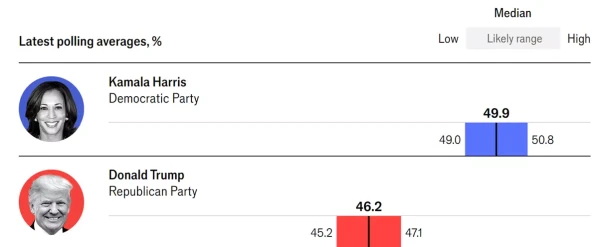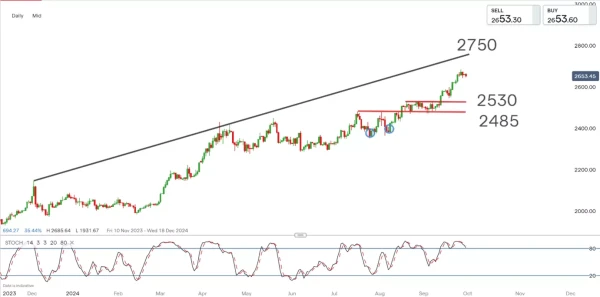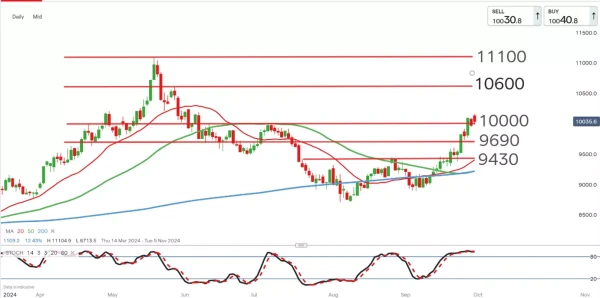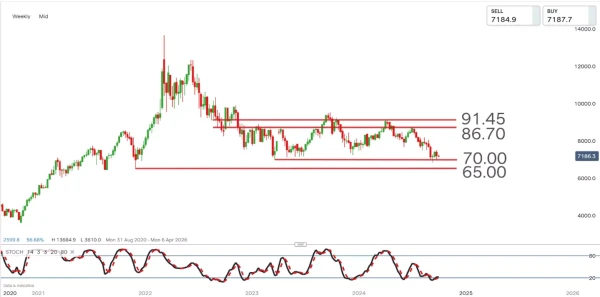US Elections: how commodity markets could be affected
Currently, election polls are suggesting that Kamala Harris is leading the presidential race as of the 30th of September 2024, albeit marginally so.
Latest polling averages, %

As with the 2016 elections the upcoming US elections (5 November 2024) are far from a forgone conclusion.
A suggested impact of a Kamala Harris election win on commodities markets
Climate Change and Renewable Energy
A Kamala Harris election win could significantly influence commodities markets through her commitment to climate change and renewable energy. An increased focus on clean energy technologies would likely boost the demand for commodities essential for these technologies, such as copper, lithium, and cobalt. For example, the push for electric vehicles (EVs) and renewable energy storage solutions would drive up the need for lithium batteries, thus elevating lithium demand. On the flip side, this shift may negatively impact fossil fuel commodities like coal and oil, as policies might lean towards reducing reliance on these energy sources to combat carbon emissions.
Infrastructure Spending and Industrial Metals
Harris's policy stance also suggests a boost in infrastructure spending, which would drive demand for industrial metals, including steel, copper, and aluminium. Infrastructure initiatives, such as building new roads, bridges, and public transit systems, require massive quantities of these materials. For instance, large-scale infrastructure projects could lead to a surge in steel demand, benefiting major steel producers and potentially driving up prices. Iron ore is a key commodity used in steel production.
Trade Policies and Agricultural Commodities
Changes in trade policies under a Harris administration could impact global commodity prices by altering trade relationships. Modifications in trade agreements or new tariffs could affect the flow and pricing of agricultural commodities like corn, wheat, and soybeans. Furthermore, shifts in subsidies or environmental regulations could influence agricultural production and pricing. For example, stricter environmental regulations might reduce the use of certain fertilizers, affecting crop yields and subsequently impacting market prices.
A suggested impact of Trump's re-election on commodities markets
Energy Sector and Fossil Fuels
A Trump re-election could lead to different commodities market dynamics, especially in the energy sector. Policies favoring deregulation and support for domestic production could boost traditional fossil fuels like oil, natural gas, and coal. This approach might result in increased domestic supply, potentially lowering prices due to higher availability. However, this policy stance could negatively impact renewable energy commodities, as the focus might shift away from clean energy investments.
Metals, Mining, and Infrastructure
Trump's policies could also affect the metals and mining sectors. Deregulation in mining could increase the supply of various metals, making them more available for industrial use. Simultaneously, proposed infrastructure spending plans could drive demand for metals like steel and copper. For example, if the administration follows through on massive infrastructure projects, the demand for steel could surge, benefiting companies in the steel production industry.
Agricultural Policies and Trade Relations
Trade policies under Trump could significantly impact agricultural commodities, especially concerning trade relations with China. Any trade agreements or tariffs could alter the flow of agricultural exports, influencing prices for commodities like corn and soybeans. Additionally, changes to biofuel mandates could affect these markets, as corn is a primary feedstock for ethanol production. A supportive stance on biofuels might increase corn demand, driving up prices.
Market Reactions to Election Outcomes
Precious Metals and Geopolitical Uncertainty
Geopolitical uncertainty often boosts safe-haven demand for precious metals like gold and silver. For instance, if market participants perceive increased geopolitical risks, there might be a rush to buy gold, driving up its price. This reaction was evident during uncertain periods in the past, where gold prices surged as investors sought safety amid turmoil.
Commodity markets and the US dollar
Both election scenarios have broader implications for the overall commodities market, primarily through their influence on the US dollar. Fiscal and monetary policies will influence the dollar, indirectly affecting commodity prices. A stronger dollar usually makes commodities more expensive for buyers using other currencies, potentially reducing demand. Conversely, a weaker dollar could boost demand for US commodities.
There is a case to be made for both election outcomes weakening the US dollar initially, however, direction will dictated by monetary policy relative to growth and the inflation outlook.
In summary
A Kamala Harris election win would likely boost demand for commodities used in renewable energy, such as copper, lithium, and cobalt, while reducing reliance on fossil fuels like coal and oil. Her infrastructure plans could also increase the demand for industrial metals like steel, copper, and aluminum. Changes in trade policies and environmental regulations could impact agricultural commodities like corn and soybeans. Conversely, a Trump re-election might favor traditional fossil fuels through deregulation and support domestic production, potentially increasing the supply and lowering prices. His policies could also drive demand for industrial metals and influence agricultural exports through trade agreements. Both election outcomes could impact precious metals as geopolitical uncertainty boosts demand for safe-haven assets like gold. Additionally, fiscal and monetary policies under either administration will affect the US dollar’s strength, indirectly influencing commodity prices.
Major Commodities in Charts
Gold (daily chart)

The long term trend for gold remains firmly up with the price having recently extended further into new all-time high territory. The move has placed the commodity into overbought territory. Trend followers might prefer to buy into a correction from overbought territory somewhere between the 2485 and 2530 support levels, whilst in search for a longer term price target at around 2750.
Copper (daily chart)

Copper appear to be a commodity which could benefit from either election outcome and will of course continue to find direction from assumptions around Chinese demand. Copper is a key commodity for a number of diversified miners.
The trend for copper has reaffirmed as up although the move has pushed the commodity into overbought territory in the near term. Traders might continue to consider buying into pullbacks, provided that a pullback doesn’t take the price back below the 200 day simple moving average (blue line). The 10600 and 11000 levels provide longer term upside resistance targets for copper.
Brent crude oil (weekly chart)

The price of brent crude remain in a broad sideways consolidation between levels 65.00 and 91.45. The price is also now trading in oversold territory around the 70.00 level.
Range traders might consider accumulating the commodity around current levels, targeting a move higher towards resistance while using a close below the 65.00 as a stop loss consideration.